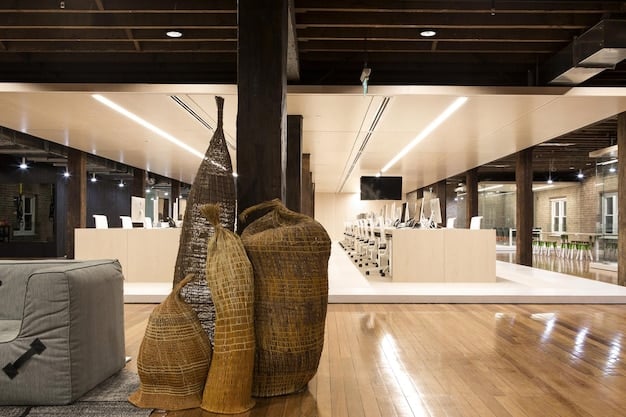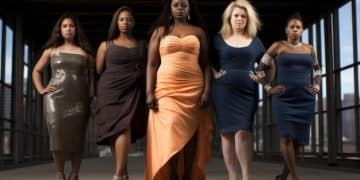American Designers Redefine Luxury: 2025 Perspectives

In 2025, American designers are redefining luxury. They merge craftsmanship with technology and a focus on sustainability.
This shift moves away from high price tags towards value. The new focus is on craftsmanship, ethics, and personal connection.
This perspective shows a powerful move from ostentation. It favors a more nuanced appreciation of true and lasting value.
The Evolving Definition of Luxury in 2025
The traditional idea of luxury is being challenged. In 2025, it is no longer just about brand recognition or status symbols.
It’s a dynamic concept tied to personal values and expertise. Consumers want products that tell a story and embody integrity.
This contemporary view emphasizes authenticity and narrative. The demand for transparency is pushing designers to be more open.
From Exclusivity to Experiential Value
The shift from exclusivity to experiential value is paramount. True luxury now lies in the emotional connection to an item.
This translates to designs that are functional and meaningful. They should resonate with individual stories and evoke feelings.
Key elements include sensory richness and narrative depth. It’s about understanding the craftsmanship behind each unique piece.
The Rise of Conscious Consumerism
Sustainability and ethical production are now mainstream expectations. Consumers are demanding greater accountability from brands.
They are pushing for eco-friendly materials and fair labor practices. Designers are integrating these principles into their core models.
This commitment adds a new layer of value to modern luxury. It appeals to buyers who prioritize impact as much as aesthetics.
Reclaiming Craftsmanship: The Human Touch in Digital Age
In an era dominated by mass production, the human touch is resurging. American designers are leading this important movement.
They are bringing traditional craftsmanship to the heart of modern luxury. This involves a deep respect for artisanal skills.
The slow, meticulous process of handcrafted goods offers permanence. It contrasts sharply with the speed of digital creation.
Artisanal Excellence as a Core Value
For many American luxury brands, artisanal excellence is a core value. It is a fundamental pillar of their entire brand identity.
This means investing in skilled artisans and preserving traditional techniques. Often, production is limited to ensure the highest quality.
The narrative behind each piece becomes as important as the piece itself. It highlights the dedication and skill poured into its creation.
The Revival of Heritage Techniques
Across design disciplines, there is a renewed interest in heritage techniques. Designers are reinterpreting these methods for the modern era.
This might involve custom tailoring or intricate hand-embroidery. Other examples include hand-blown glass and ceramic artistry.
This commitment fosters superior products and sustainable practices. It supports local economies and preserves cultural heritage.
Innovation Beyond Technology: Materials and Processes

Innovation in American luxury extends beyond just digital advancements. It penetrates deep into the realm of materials and processes.
Designers are pushing boundaries by exploring novel materials. They are embracing circular design and sustainable production methods.
This focus on material innovation includes bio-based textiles. It also involves recycled composites and nanotechnology for durability.
Sustainable Material Revolution
The search for truly sustainable materials is transforming the industry. American designers are leading this important charge.
They integrate everything from lab-grown diamonds to mushroom leather. Upcycled fabrics and innovative bio-plastics are also used.
These materials, like vegan leathers and recycled metals, reduce impact. They do so without sacrificing the quality of luxury goods.
Advanced Manufacturing Techniques
While craftsmanship is celebrated, luxury also embraces advanced manufacturing. This enhances precision and enables complex designs.
This includes the strategic use of 3D printing and laser cutting. These tools are used to complement the human element, not replace it.
The synergy between materials and processes creates a distinct aesthetic. It is both globally conscious and distinctively modern.
The “Made in America” Seal: A New Prestige
The “Made in America” label is experiencing a significant resurgence. It is a powerful symbol of quality and ethical production.
For consumers, it signifies support for local economies. It also ensures fair labor practices and meticulous attention to detail.
This renewed prestige elevates the value of American brands. It is about how something is made and the values it represents.
Supporting Local Economies and Craftsmanship
By manufacturing domestically, designers support local industries. This helps preserve artisanal skills within the United States.
This commitment translates into job creation and community impact. It also allows for much closer oversight of quality control.
Another benefit is a reduced carbon footprint from shorter supply chains. This fosters a vibrant and sustainable creative ecosystem.
Transparency and Ethical Production
The “Made in America” status offers a higher degree of transparency. This applies to both labor conditions and environmental practices.
It often adheres to stricter regulations than overseas production hubs. This provides peace of mind for the luxury consumer.
By tracing a product to its American origins, buyers feel more confident. This defines the new prestige of American-made luxury.
Storytelling and Brand Identity in Luxury
In 2025, the narrative around a luxury product is crucial. American designers are masters of effective storytelling.
This involves crafting narratives that connect on an emotional level. It creates a universe around the brand that customers join.
The goal is to build a community around shared values. A luxury purchase becomes a declaration of personal identity.
The Designer’s Vision as Narrative
The designer’s personal story and creative vision are central. Consumers are drawn to products with a distinct artistic voice.
Designers share their inspirations and creative processes. This makes the brand feel more relatable and authentic.
This human connection is what fosters loyalty. It helps to differentiate brands in a very crowded global market.
Curating the Customer Experience
Luxury is an intrinsically experiential concept. American designers excel at curating immersive customer journeys.
From personalized consultations to beautiful packaging, every touchpoint matters. It reinforces the brand’s narrative and deepens the connection.
This holistic approach ensures luxury items are not just purchased. They are truly experienced, cherished, and valued by the consumer.

The Digital Frontier: Personalization and Direct-to-Consumer Models
The digital landscape has dramatically altered the luxury market. Designers use it to enhance personalization and forge direct connections.
The direct-to-consumer (DTC) model cuts out intermediaries. This allows designers greater flexibility and higher margins.
This digital transformation also facilitates hyper-personalization. It mirrors the exclusivity of private showrooms for a digital audience.
Hyper-Personalization at Scale
Technology enables designers to offer a new level of personalization. This was previously unimaginable on a larger scale.
This includes custom configurations online and virtual AR/VR try-ons. AI-driven recommendations also suggest curated products.
Bespoke design services can be facilitated through digital consultations. This allows for efficient management of diverse customer requests.
Empowering the Direct-to-Consumer Model
The DTC model empowers designers to build stronger relationships. This direct interaction provides them with invaluable feedback.
This fosters brand loyalty and allows for greater agility. The brand’s story is communicated authentically without dilution.
By owning the entire customer journey, designers offer a seamless experience. This reinforces the exclusive nature of their luxury offerings.
Future Outlook: American Luxury in a Global Context
As 2025 unfolds, American luxury design continues to evolve. Its global influence is steadily increasing.
Their definition of luxury is rooted in authenticity and ethical production. It is likely to become a new benchmark worldwide.
The “Made in America” narrative will gain even greater traction. Global consumers are actively seeking trust and authenticity.
Collaborations and Cross-Cultural Exchange
The future of American luxury will involve more strategic collaborations. These can be both domestic and international partnerships.
These partnerships can bring together diverse skill sets. They foster cross-cultural design dialogues and expand market reach.
Collaborations might intertwine luxury with art and culture. This creates unique, limited-edition products that generate buzz.
Education and Mentorship
To sustain this growth, investment in education will be critical. Mentorship for the next generation of designers is essential.
Nurturing talent and preserving crafts will ensure the sector stays vibrant. Integrating new technologies is also key to this process.
This commitment shapes the very essence of what luxury means. It is about a dynamic ecosystem of creativity, ethics, and skill.
| Key Aspect | Brief Description |
|---|---|
| ✨ Evolving Luxury | Luxury now signifies value, storytelling, and ethical impact over simple exclusivity. |
| 🎨 Craftsmanship Revival | Human touch and artisanal skills gain prominence, combining heritage with modern appeal. |
| 🌿 Material Innovation | Focus on sustainable, bio-based, and recycled materials for ethical design. |
| 📱 Digital Personalization | Direct-to-consumer models leverage tech for bespoke customer experiences. |
Frequently Asked Questions
Luxury in American design in 2025 is defined by a blend of superior craftsmanship, ethical sourcing, innovative materials, and a deep, personal connection with the consumer. It prioritizes authenticity, sustainability, and unique narratives over sheer exclusivity or brand recognition.
American designers are integrating sustainability through eco-friendly materials like vegan leathers and recycled metals, adopting circular design principles, and ensuring ethical labor practices. They prioritize transparent supply chains and responsible manufacturing to reduce environmental impact.
“Made in America” now signifies prestige, assuring consumers of high quality, ethical production standards, and support for local economies. It offers greater transparency and reinforces a commitment to skilled domestic labor, resonating with values-driven buyers.
Technology influences American luxury design by enabling hyper-personalization through AI-driven recommendations and virtual try-ons. It facilitates direct-to-consumer models, strengthening brand-consumer relationships and streamlining bespoke services, enhancing the overall luxury experience.
Storytelling is crucial for luxury brand identity, connecting consumers emotionally with the product’s journey, the designer’s vision, and the passion of the makers. It creates an immersive brand universe that fosters loyalty and transforms a purchase into a meaningful experience.
Conclusion
The landscape of luxury in 2025 reflects a profound transformation driven by American designers. Their vision extends beyond mere opulence, embracing a definition of luxury that champions craftsmanship, mindful innovation, and a deeply personal connection with the consumer.
By prioritizing ethical production, sustainable materials, and compelling narratives, these designers are not just creating objects of desire, but shaping a more meaningful and responsible future for the entire industry.
Their forward-thinking approach cements the United States’ position as a potent force in redefining global luxury standards.





